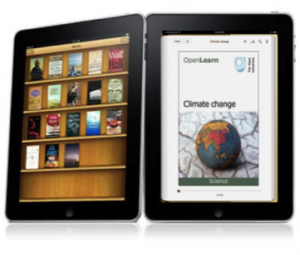The advent of Open Education Resources (OERs) has seen a significant change in higher education practice. Professor Martin Weller tracks its development and previews his forthcoming OER Research Hub project.
 About the author: Professor Martin Weller, Institute of Educational Technology at The Open University. His publications include: The Digital Scholar: How Technology Is Transforming Scholarly Practice. (2011, Basingstoke: Bloomsbury Academic); Virtual Learning Environments: Using, Choosing and Developing your VLE. (2007, Oxford, UK: Routledge);Delivering Learning on the Net: the why, what and how of online education. (2002, Open and Flexible Learning. London, UK: RoutledgeFalmer).
E-mail: martin.weller@open.ac.uk
Blog: The Ed Techie
Web: http://iet.open.ac.uk/people/m.j.weller
About the author: Professor Martin Weller, Institute of Educational Technology at The Open University. His publications include: The Digital Scholar: How Technology Is Transforming Scholarly Practice. (2011, Basingstoke: Bloomsbury Academic); Virtual Learning Environments: Using, Choosing and Developing your VLE. (2007, Oxford, UK: Routledge);Delivering Learning on the Net: the why, what and how of online education. (2002, Open and Flexible Learning. London, UK: RoutledgeFalmer).
E-mail: martin.weller@open.ac.uk
Blog: The Ed Techie
Web: http://iet.open.ac.uk/people/m.j.weller
It seemed like a noble, but commercially foolish idea – for universities to ‘give away’ their teaching content for free. Yet the open education movement has expanded rapidly over the past decade and is now reaching a level of maturity and sustainability. This means it is ripe now to start researching some of the movement’s key assumptions and beliefs. This is what a new project at the Open University aims to do.
The Open University is arguably in a unique position to consider the nature of what ‘open’ means in higher education.
When it was founded it had a particular definition of open to mean open access, which was realised through not setting any formal educational qualifications for entry, and using a part-time, distance education model. But with the advent of the Internet and digital technologies, what it means to be ‘open’ with regards to education has begun to change.
In particular the advent of Open Education Resources (OERs) has seen a significant change in higher education practice. These can be whole courses, parts of a course, lecture notes, video lectures etc. The key characteristics are that they are free to use, and have a copyright licence, which encourages reuse.
The OER movement (although even calling it a movement can be contentious) grew out of earlier work around ‘Learning Objects’. As e-learning moved into the mainstream around the year 2000, educators and institutions found they were creating often expensive learning resources from scratch. There was a relentless logic, that with the digitisation of content, these resources could be shared between institutions.

However, the learning object approach failed to take hold. Part of the problem of learning objects was that it often seemed alien to everyday practice, so that getting educators to share their content in learning object repositories proved to be a barrier. Unlike sharing research findings in published journals, or sharing teaching resources informally within an institution, there was no real incentive or established practice for sharing teaching material on this scale.
In 2001 the OER movement began when MIT announced its OpenCourseWare initiative, the goal of which was to make all of the learning materials used by MIT's faculty in the school's 1,800 courses available via the Internet where they could be used and re-purposed as desired by others without charge.
At the time this was revolutionary, since much of the accepted wisdom was that content was a key asset (the adage was that ‘content is king’), and it couldn’t be given away. It also addressed some of the issues, which were arising with learning objects, since it took existing teaching content, and simply released it. In reality, it wasn't that simple to release it, since the material often required reversioning, rights clearance, or some form of adaptation. But nevertheless it didn't rely on individual educators engaging with complicated standards and adopting a new set of practices. It built on existing practice in that it took existing course materials and released these, rather than developing bespoke learning objects.
… part of the problem of learning objects was that it often seemed alien to everyday practice
Others followed suit including the Open University with its OpenLearn project, which has released over 11,000 hours of free distance learning material. In addition to these institutional projects, other outlets provided educational spaces, including YouTube and iTunes U. Suddenly there was a wealth of reliable, free material available. More recently free online courses, so-called MOOCs (for Massive Open Online Courses), have been offered by Harvard, MIT, Stanford and others, with student enrolments in excess of 100,000.
The open education movement has generated a good deal of research, but often at the case study level. The William and Flora Hewlett Foundation in the United States (who funded much of the initial OER work including MIT’s OpenCourseWare and the OU’s OpenLearn projects) are interested in gathering together the evidence that supports, or even contradicts some of the beliefs and statements that accompany the OER movement. To this end the Institute of Educational Technology at the OU is conducting a two-year research project to develop an OER Research Hub. This project has identified twelve research hypotheses in OER, with the aim of providing future decision makers with firm evidence when they consider engaging with OER. The overarching theme of the research is ‘What is the impact of OER on learning and teaching practices?’, and it will address issues such as financial benefits, institutional policy as well as assessment and student satisfaction.
 By collaborating with eight international partners that will target specific research questions across four key sectors (K-12, college, higher education and informal learners) the project aims to gather solid evidence base for these hypotheses. At the same time it will gather and analyse existing evidence from other projects.
By collaborating with eight international partners that will target specific research questions across four key sectors (K-12, college, higher education and informal learners) the project aims to gather solid evidence base for these hypotheses. At the same time it will gather and analyse existing evidence from other projects.
There are a number of beliefs that are often stated for OERs, such as that using them leads to a cost reduction in course production. While this seems obvious, there may be confounding factors, such as the time taken to find and then modify the resources. The Research Hub seeks to provide a firmer evidence base for these claims. It may be that some are weaker than is commonly believed, or only apply under certain circumstances. For instance, it could be the case that for some learners the use of OER doesn't lead to a significant cost reduction, but the resultant variety in course material leads to greater student satisfaction. It is establishing these kinds of recommendations that are the aim of the project.
The two-year project has just commenced and will be adopting an open policy to dissemination, including publishing in open access journals, use of social media, releasing open data, aggregating other research and running an open conference. The first tasks are to establish the research hub, which will act as the central dissemination source, and to finalise the research approaches with each of the collaborations. With projects as diverse as teacher training in India, the use of open textbooks, learner motivation in MOOCs and community college student retention, there is a considerable planning and coordination phase under way. Each of these projects will have a fellow who will visit the Open University for a period, creating a network of researchers. This model was successfully deployed on a previous project, OLnet (www.olnet.org). You can find out more about the project by following us on twitter (@OLnet_OER_Hub)
As the recent announcement from BFI to release 10,000 films online demonstrates, the concept of opening up archives has spread beyond purely higher education institutions. By establishing a firm research basis on which others make decisions, the OU team hopes to enrich further the global open archive. Any resource can be viewed as an educational resource after all, if it is used in the appropriate context, so the benefits of using, sharing and remixing OERs goes beyond higher education to any activity that involves learning. There are many implications for film – communities with an interest in an obscure genre can create their own MOOC, individuals can remix resources from different providers to contrast works, open works can be translated, or analysed with group annotations, and so on. It is the open aspect of OERs that allows for unpredictable and innovative use.
Professor Martin Weller